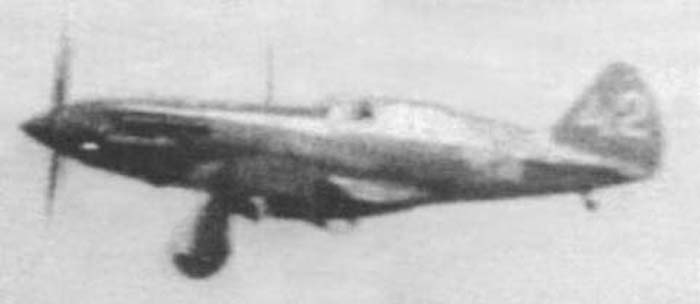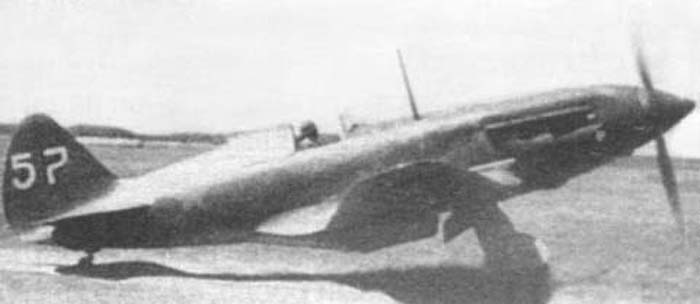|
MiG-3s on war on summer 1941
|
last modified on December 20, 2003
file name: summer.html
The geographical organization of the Soviet Air Forces
At the start of the war, the Soviet Front and Army Air force were organized
by districts:
Leningrad Military District (later Northern Front);
Baltic Special Military District (later Northwest front);
Western Special Military District (later Western Front);
Kiev Special Military District (later Southwest Front);
Odessa Military District (later Southern Front).
The Soviet Navy Aviation was organized so:
Northern fleet
Baltic Fleet
Black Sea Fleet.
Besides, before the war, the PVO (Protivovozdushnogo Oborona, Anti-Air
Defence forces) was created, including interceptors units, anti-aircraft
guns and searchlights units, to coordinate them; else, it was difficult
to coordinate the fighters units of the VVS with artillery units of the
Army.
The 6th IAK-PVO (Fighter aviation Corp of the Air Defence) was created
on 20 June 1941 to defend Moscow, while 7th IAK-PVO was created on July
7 to defend Leningrad, and 8th IAK-PVO in November to defend Baku.
At first, the coordination action of the PVO was theoretical, but later
(from January 1942) the PVO became effectively a separate arm of the Soviet
Armed Forces, as the Army, Navy and Air Force.
Some elite fighter Regiments
Five new regiments were staffed by test pilots, on initiative of the
Hero of the Soviet Union Stepan Suprun; such elite units should try to
regain air superiority, and give to other pilots examples of how to use
new fighters.
Two of those Regiments, the 401 IAP headed by S. Suprun himself, and
the 402 IAP led by Lieutnant Colonel Peotr Stefanovsky, were equipped with
67 newly built MiG-3 fighters, and sent to the front on June 30.
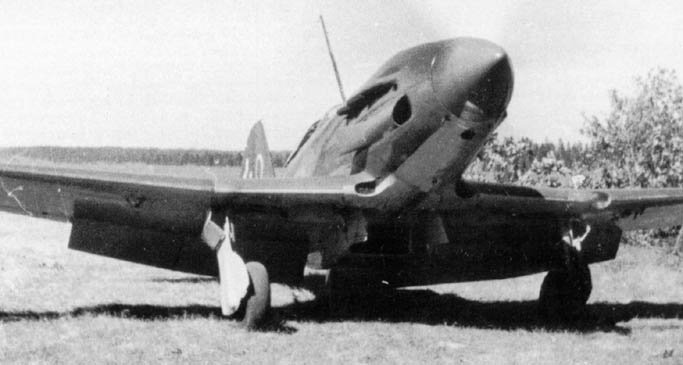 |
The 401 IAP was based on the airport of Zubovo near Smolensk, on the
Western Front, and was employed on intensive ground attack, reconaissance
and air combat at low or medium altitude, shooting down 8 enemy aircrafts
on July 2 and 3.
On July 4, Suprun alone had to attack some German aircrafts marauding
his airport, shooting down a Ju-88, but then he was shot down by an escort
Bf-109 and died.
During his last day, he downed four enemy aircrafts.
He was posthumously awarded as Hero of the Soviet Union for the second
time. |
The 402 IAP, based on the Velikie Luki airfield in the Leningrad District,
had Captain Proshakov as one of its most able pilots, performing even a
subcessful night interception of Dornier bombers over Idritsa, shooting
down one of them, and then landing in the darkness on the unprepared airfield
using only his own landing light.
During the summer, both 401 IAP and 402 IAP were assigned to the Moscow
Air Defense (PVO).
Another regiment able to fly well the MiG-3 was the 55 IAP on the Southern
Front; it was the unit of the future Hero of the Soviet Union Alexander
Pokryshkin, that obtained his first 12 victories on a MiG-3; of these,
5 were on Bf-109E of Jagdgeschwader 77.
He was one of the first pilots to understand that the good manoeuvrability
of the MiG-3 on the vertical plan should be exploited flying high, then
diving on the enemy gaining speed, use it to choose a good firing position,
fire and then pitch to regain altitude and to subtract to the reaction
of the enemy.
Some high-altitude combats were subcessful, demonstating that many defects
shown on early aircrafts were resolved.
On September 28, 1941, the pilot B Pirozkhov of 124th IAP , Moscow
PVO, intercepted an enemy reconaissance plane at 8,000 m altitude, and
followed it till to 10,000 m altitude shooting it down.
Moscow front
Before the war, the PVO (Protivovozdushnogo Oborona, Anti-Air Defence
forces) was created, including interceptors units, anti-aircraft guns and
machine guns units, searchlights units and balloons, to coordinate them;
else, it was difficult to coordinate the fighters units of the VVS with
artillery units of the Army.
The PVO of Moscow was officially created on February 14, 1941, headed
by General M.S. Gromadin.
The fighters regiments of the PVO were based within a range of about
120 km from the centre of Moscow; it should operate within a range of 200
km, and it had to intercept enemy aircrafts before they arrive closer than
80 km from the centre; they were intended both for day and night interceptions.
The 6th IAK-PVO (Istrebitelnyi Aviatsionnyi Korpus, Fighter aviation
Corp of the Air Defence) was created on 20 June 1941 to defend Moscow,
on the base of the former 24th IAD and of the administration of 78 IAD
(a division still on constitution). It was headed by Colonel I.D.
Klimov.
On July 1941, the 6th IAK had about 700 fighters, of which about 200
were MiG-3s.
The 6th IAK included the following fighter regiments:
| 11th IAP; |
Yak-1 |
|
|
| 16th IAP |
MiG-3 |
|
commanded by Lieutnant Colonel T. Prutskov; it destroyed 72 enemy aircrafts
during 1941 |
| 24th IAP; |
|
|
|
| 27th IAP; |
MiG-3 and I-153 |
|
commanded by Major A.Pisanko |
| 34th IAP; |
MiG-3 |
|
commanded by Major L Rybkin, it distinguished itself in the protection
of ground objectives as troops and railway traffic, and operated intensely
even with bad weather. |
| 120th IAP; |
MiG-3 and I-153 |
|
120 IAP, that distinguished himself and was made Guards as 12 GvIAP
on March 1942. |
| 176th IAP; |
|
|
|
| 177th IAP; |
|
|
|
| 178th IAP; |
I-16 and LaGG-3 |
|
|
| 233th IAP; |
|
|
|
| 309th IAP; |
|
|
|
| 123th IAP; |
MiG-3 |
from June |
|
| 124th IAP; |
MiG-3 |
from June |
|
| 126th IAP; |
|
from June |
|
| 401th IAP; |
MiG-3 and Yak-1 |
from June |
|
| 402th IAP; |
MiG-3 and Yak-1 |
from June |
|
| 95th IAP (ex 95th SBAP); |
Pe-3 |
from September |
|
| 208th SBAP |
Pe-3 |
fromOctober |
|
Besides, the Moscow area was defenced by the 77 SAD (mixed Air Division),
including 41th IAP, 28th IAP(MiG-3) and 29th IAP (I-16) with some other
units.
Besides fighters units, ballons and artillery, the PVO of Moscow has
5 experimental radar station RUS-1 and RUS-2, alongside acustical localization
devices.
During the first days of July, some German reconaissance planes flew
over Moscow, forthemost without being intercepted, despite their altitude
and speed were not high enough to make them difficult to reach. Besides,
there are some losses for friendly fire, when fighter pilots shot down
some Soviet aircrafts. At the very beginning of the war, both the fighter
pilots, the AA gunners and the coordination system performed unsatisfactorily.
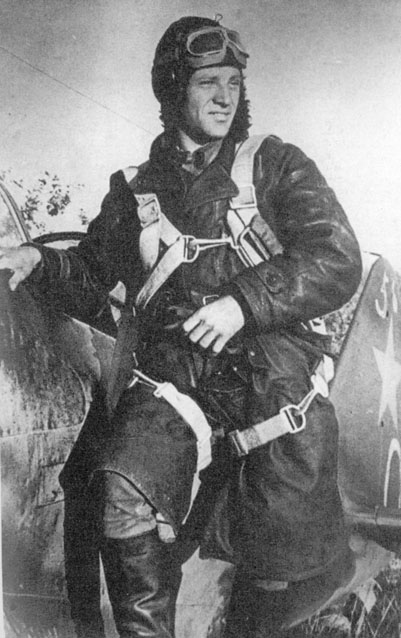 |
The MiG-3 was produced in wide quantity during the summer and fall
1941, so it was widely diffused, particularly between the PVO units defending
Moscow.
This is a photo of captain A.A.Lilipin, of 41 IAP, that shot down a
German reconaissance plane at an altitude of 8000 m on 27 July 1941.
The aircraft is an early MiG-3 with a green and black scheme with unusually
soft demarcation lines.
At the top of the tail there is a sign 5 (perhaps referred to
5 air victories); on the bottom, number 0 designates a commander aircraft.

|
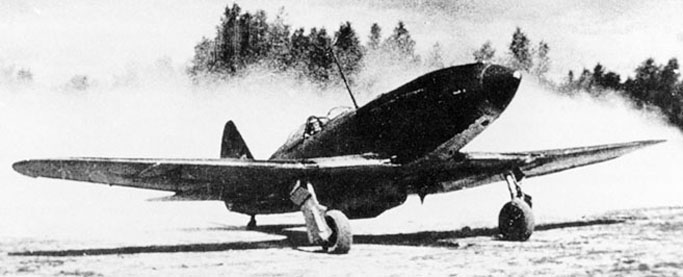 |
This photo shows a taxiing example, probably on the Moscow front.
Note the field modified undercarriage doors.
This phenomenon of much dust is common in northern Russia, just where
many MiGs were located. In the fall, just after the rain stops (maybe October-November),
the dried mud turns to big dust storms. This continues for a couple of
weeks until the cold and snow arrives.
from OKB MiG |
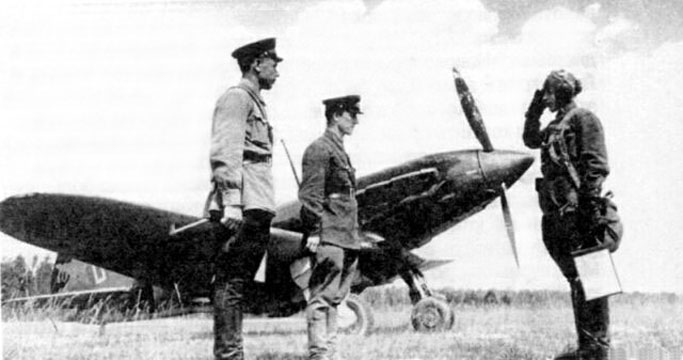 |
Here is another image of the same aircraft, with its pilot and some
officers.
It is recognizable because of the modified doors.
From D.Hazanov: Unknown battles on the Moscow skies vol.1

|
 |
This photo represents a MiG camouflaged with small trees while being
refuelled by a tank truck, probably of the 402 IAP on the Moscow front.
The MiG is a later type with inlet pipe for inert gas over its left
exhaust rack; late type MiG-3s appear on July or August 1941; they are
easily distinguishable for different cowling of exhaust stacks, long gun
barrel fairings, different engine cowling panelling. They usually feature
slats too, and other less evident changes.
This aircraft was probably painted with low contrast green/dark green
camo, and its undercarriage doors appear striped green or black. The propeller
blades appear green camouflaged too. |
Northern front
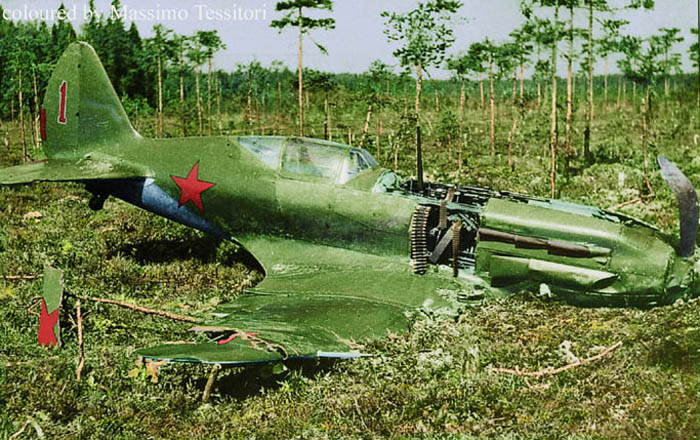
|
This example was piloted by Lt. N.M.Estyen and made a forced landing
after being hit by AA fire near Utti air base in southern Finland on July
12, 1941.
The unit was a detached fighter squadron (OIAE) of the Baltic fleet.
Many remains are still in the Vesivehmaa
museum in Finland.
The photo was colorized by the author.

|
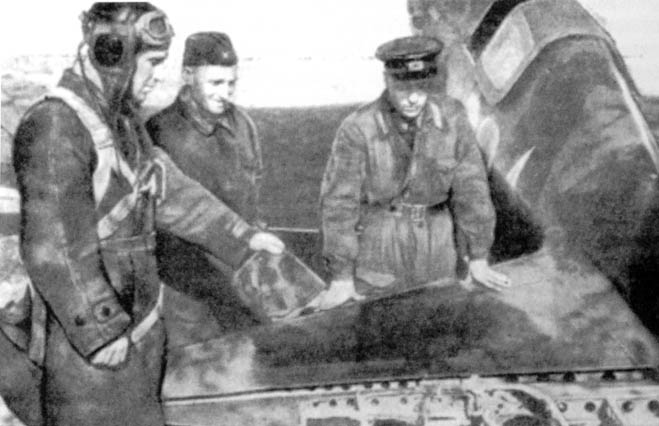 |
The Lieutnant Pavel Tarasov of 12 IAP shows the damage sustained by
his MiG during combat with a German Me-109.
This photo is believed to have been made on the first days of July
1941.
On July 5, 1941 Tarasov shot down two Me-109s, plus a third one in
a taran attack (intentional collision), bailing out from his Yak-1despite
injuries on both hands and on a leg.
Pavel Tarasov claimed a total of 25 aerial victories in 235 sorties,
before being killed in a flight accident on July 29, 1944.
It's not clear if the strange blotches are due to a field camouflage
or shadows of a camouflaged net.
The aircraft should be an early MiG-3 with radio, black and green camouflage
and an unrecognizable white number (20 or 30?); note the unusually small
star.
from Black Cross- Red Star vol.1 |
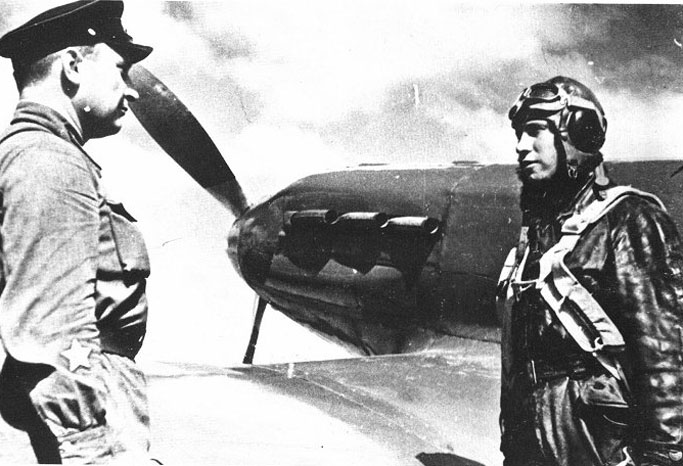 |
Lt. D.S. Titarenko, of 19 IAP of Leningrad Air Defense, shot down a
Ju-88 on July 6, 1941.
It was the first German aircraft shot down over Leningrad, the crew
was captured.
Titarenko is reporting a victory to Brigade Commissar F.F. Verov in
front of his MiG-3.
The plane is an early MiG-3; its nose and wingroot seem painted black,
with partially white spinner.
from Batailles Aeriennes |
Southwest front
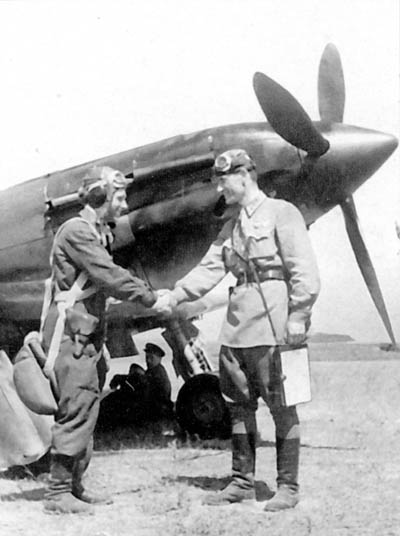 |
Pilot K.M.Marchev was congratulated for an air victory, on the southwest
front, during August 1941.
Note that his late type MiG-3 has a non-standard mottling on his nose
and propeller. |


